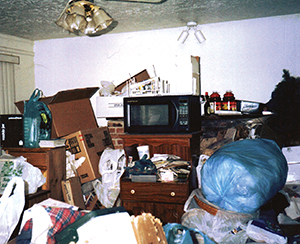System trains family, professionals to identify the disorder, intervene with empathy
By NANCY FRAZIER O'BRIEN
Hoarding may seem like an isolated phenomenon, affecting only the hoarder and his or her family members. But its effects go far beyond the individual and into the community, in terms of fire hazards, lost work days, evictions, animal neglect and abuse and the societal support needed when children or elderly family members are removed from the home.
Pittsburgh Mercy Health System, part of Livonia, Mich.-based CHE Trinity Health, is helping to educate health and human services professionals and the community about how to identify and respond to those affected by the hoarding disorder.
Formally recognized only last year as a separate disorder in the Diagnostic and Statistical Manual of Mental Disorders, Fifth Edition:DSM-5, it is estimated to affect between 2 to 5 percent of the U.S. population. Earlier editions of the DSM had classified hoarding under obsessive-compulsive disorder.
Kihra A. Kohler, training and development coordinator at Pittsburgh Mercy Health System, began including a workshop on hoarding among the system's educational offerings last year. The four workshops held so far have attracted "a very wide range of people," including clinicians, caregivers in residential settings, certified peer support specialists and "a few individuals who felt they may have the disorder themselves and wanted more information," she said.
A primary goal of the daylong workshop is to help people identify and respond appropriately to those affected by the hoarding disorder, and to learn what is and isn't hoarding.

"Someone who is messy but doesn't have a problem getting rid of items is not a hoarder," said Kohler, who holds a master's degree in psychology. "An individual with hoarding disorder is going to have an extremely difficult time getting rid of an item that they associate with a memory, or a feeling, or a person."
For example, if they are asked to throw away something that belonged to their late mother, even an item that others would consider trash, "they may feel like they are throwing away their mom," she said.
It's also easy to distinguish between a collector and a hoarder, Kohler said, because a collector "is able to determine the actual value or worth of an item, will put it on display and is able to set boundaries on how many items to acquire."
Hoarding "tends to be triggered by some traumatic event" and often starts when a person is in his or her 20s, Kohler said. Some hoarders fill their houses with live animals, others are unable to part with broken furniture, magazines, clothing or even food wrappers. The goods pile up in mountains and mounds and can reduce the living space to claustrophobic proportions and pose fire hazards and access barriers for first responders.
"The treatment plan is always going to be focused on the level of hoarding, not on what the individual hoards," Kohler said.
"Research shows that hoarding could be a hereditary trait, but it doesn't have to be," she added. "It occurs more often in women than in men, but not at a rate that is statistically significant."
Kohler represents Pittsburgh Mercy Health System on the hoarding task force developed by the Allegheny County Department of Human Services' Office of Behavioral Health. Members of the task force began meeting regularly about two years ago. They are working to address the hoarding problem both as a public health concern and as an individual mental health issue.
Lucille Underwood heads the task force and serves as assistant disaster coordinator for the Office of Behavioral Health. She said the extent of the hoarding problem surfaced after the southwestern Pennsylvania county experienced severe flooding about 10 years ago. County employees going door-to-door to offer assistance came across a number of flooded homes that were overfilled with belongings.
She described a typical hoarder as "someone who has had losses in life that made a great impact on them" and who as a result "doesn't want to get rid of anything.
"Family members can get agitated, angry and frustrated because they do not understand that this is a mental illness, not something (the hoarder is) choosing to do," Underwood added. "They don't realize that (the hoarder) needs to go and talk to someone about what they have lost. It's very, very sad because they don't realize they need to get help."
The disorder "crosses all income levels," Underwood noted. She recalled one woman living in a "well-to-do neighborhood" and married to a firefighter who was found to be hoarding — a problem that, ironically, often poses a fire hazard.
Underwood said the Allegheny County task force on hoarding has had difficulty putting its ideas into action because of a shortage of county funds, but she has begun a support group for those with the hoarding disorder and hopes to get three more started soon.
"Support is so important," she said. "It's crucial to talk with people who have like problems."
The Allegheny County official also hopes to get a staff member trained "to go in and clean up appropriately," she said. "It's a process that requires a person to be very patient and supportive. It's slower than you and I would want to do it."
Pittsburgh Mercy's Kohler plans to continue to offer the workshop on hoarding twice a year — and more often if the demand increases.
"When working with someone (who is hoarding) you need to keep in mind that they see these items as protection, as unconditional love," she said. The items "are never going to leave them or hurt them, and that has been their main experience with people.
"The primary goal needs to be love and protection," Kohler said, "and assuring them that help is available."
Copyright © 2014 by the Catholic Health Association
of the United States
For reprint permission, contact Betty Crosby
or call (314) 253-3477.